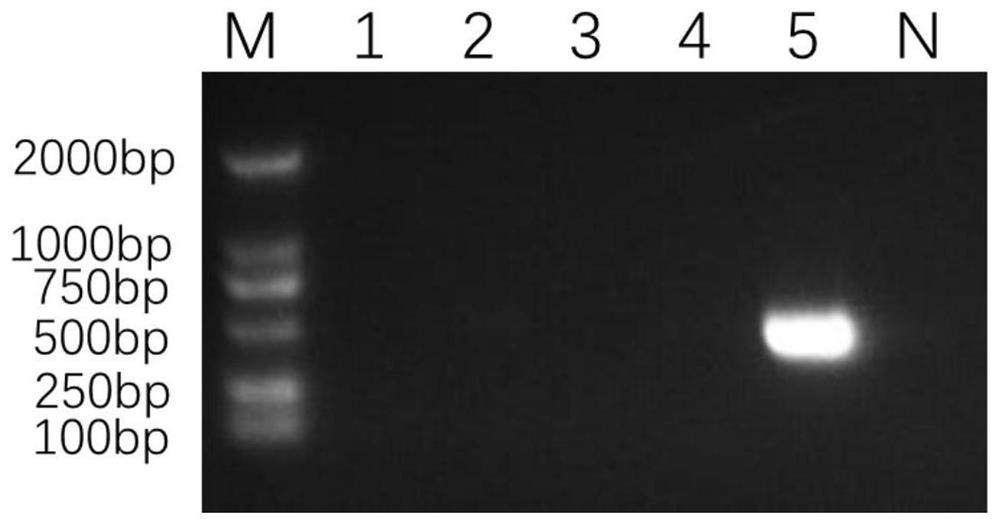Small RNA (Ribonucleic Acid) virus gene of white foot shrimp and application of small RNA virus gene
A technology of RNA virus and white-legged shrimp, which is applied in the field of detection of aquatic pathogens, can solve problems such as production decline and loss of farmers, and achieve high sensitivity, good linear relationship, good repeatability and specificity
- Summary
- Abstract
- Description
- Claims
- Application Information
AI Technical Summary
Problems solved by technology
Method used
Image
Examples
Embodiment 1
[0059] The design of embodiment 1 nested PCR primer and the establishment of method
[0060] 1. Design of nested PCR primers
[0061] The present invention has discovered a new small RNA virus, tentatively named Macrobrachium rosenbergii picorna virus12 (MrPV-12 ), whose genome sequence is shown in SEQ ID NO.1.
[0062] At the same time, the present invention refers to the phylogenetic analysis of Picornaviridae of Picornaviridae by the International Committee on Taxonomy of Viruses, selects a relatively conservative RNA polymerase gene, and constructs a tree through Bayesian, to represent representatives of multiple genera in 8 families of Picornavirales. species, tentative species not classified into genus, and a plurality of MrPV viruses (MrPV-1, MrPV-4, MrPV-7 and MrPV-12) found by the inventors of the present invention have carried out phylogenetic analysis, and the analysis results are as follows figure 1 shown. It can be seen from the figure that MrPV-12 is closely r...
Embodiment 2
[0078] The construction of embodiment 2 positive recombinant vector and the optimization of nested PCR reaction conditions
[0079] 1. Construction of positive recombinant vector pMD19-T-MrPV-12
[0080] Using the cDNA obtained by reverse transcription in Example 1 as a template, the method of the first round of nested PCR in Example 1 was used to amplify the gene sequence of SEQ ID NO.2 with a primer MrPV-12-1-F / R and sequenced . Compare the sequence obtained by sequencing with the assembled sequence of the macrovirus group. If the sequence is consistent, use the pMD of TaKaRa TM 19-T Vector Cloning Kit, the gel-cut recovery product was connected to the pMD-19T vector to construct a recombinant vector. carrier carrier carrier
[0081] 2. Optimization of annealing temperature
[0082] With a concentration of 10 4The positive recombinant vector of copies / uL is used as a template, and the first expansion primer MrPV-12-1-F / R and the second expansion primer MrPV-12-2-F / R ar...
Embodiment 3
[0090] Embodiment 3 Sensitivity, repeatability and specificity detection
[0091] 1. Sensitivity and repeatability detection
[0092] In order to detect the sensitivity and repeatability of the nested PCR primers, a concentration of 10 7 Copies / uL of positive recombinant vectors were sequentially diluted 10 times in 8 gradients. Using different concentrations of positive recombinant vectors as templates, PCR amplification was carried out with first-amplification and second-amplification primers respectively. The experiment was repeated three times, and the PCR products were detected by electrophoresis.
[0093] The sensitivity and repeatability detection results of the first amplification primers are as follows: Image 6 As shown, it can be seen from the figure that the results of the three amplifications are consistent, and the minimum detection limit of the primers for the first amplification is 10 5 copies / uL. Sensitivity and repeatability detection results of the secon...
PUM
| Property | Measurement | Unit |
|---|---|---|
| Dilution | aaaaa | aaaaa |
| Positive detection rate | aaaaa | aaaaa |
Abstract
Description
Claims
Application Information
 Login to View More
Login to View More - R&D Engineer
- R&D Manager
- IP Professional
- Industry Leading Data Capabilities
- Powerful AI technology
- Patent DNA Extraction
Browse by: Latest US Patents, China's latest patents, Technical Efficacy Thesaurus, Application Domain, Technology Topic, Popular Technical Reports.
© 2024 PatSnap. All rights reserved.Legal|Privacy policy|Modern Slavery Act Transparency Statement|Sitemap|About US| Contact US: help@patsnap.com










